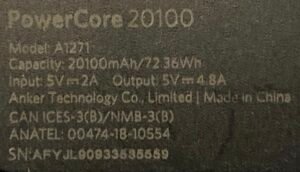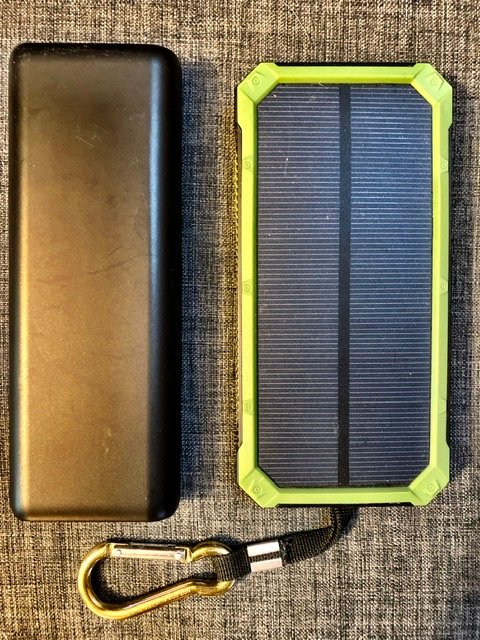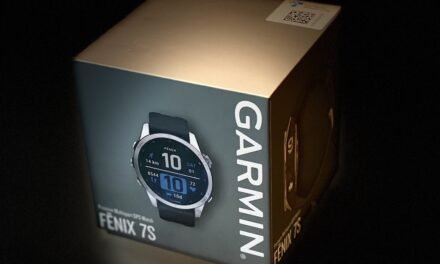We are all taking more electronic gadgets on the trail. For me, this is at least a Garmin Inreach Mini, cellphone, and watch. These are a combination of safety and convenience. I use my cellphone for navigation (always have a paper backup) and I just like having my watch with me. Of course, if you are only going for a short overnight or weekend trip this is less of a problem. But if you are on a long hike and away from any recharging source for 5-10 days that you really have to think of a power management plan. This is how I ended up picking the Anker Powercore 20100.
Introduction to batteries
Without getting too much into the details of batteries – one of the most important numbers to worry about is its capacity. This is typically measured in milliamperes per hour or often shortened to mAH. To start with it’s enough to say that this measures how much energy a better can store. So generally the bigger the number the more energy the battery can store, but unfortunately the heavier the battery is.
For some typical devices – this is the capacity of the battery:
- Garmin InReach Mini – 1250 mAh
- Garmin Explorer+ – 3100 mAh
- Iphone 11 – 3110 mAh
- Iphone 12 – 2815 mAh
- Apple Watch 4 – 292 mAh
- Nitecore NU25 headlamp – 610 mAh
Typical battery packs range between 10000 and 20000 mAh for backpacking. So now you can see the basic relationship. If you have a 10000 mAh battery pack you should be able to recharge your iPhone about 3 times.
Solar or not Solar?
One of the ongoing debates is whether to use solar. There are two different types of solar. Those are a single solar cell built into a battery back and those which are a series of connected cells. There are a couple of things to understand about solar:
- A single, typical small solar cell might produce something like 200ma – under perfect conditions – so under an hour of perfect lighting you’d get 200mAh. And so to charge a 10000 mAh battery back it would take around 50 hours. One heck of a long time.
- You rarely get perfect conditions. Even if you tie it to your backpack – if you are hiking into the sun rather than away from the sun – you will get nowhere near the results, And hiking through shaded trees will kill the charging.

My first battery pack was one of these. The idea of having a solar panel and all the other gimmicks seemed attractive and the price was about right. However, even though it’s rated at 13000 mAh I am pretty convinced that its performance was less than my son’s 10000 mAh Ravpower.
So in hindsight, I would not recommend getting one of these – even though they are plentiful on Amazon. They just don’t perform and the solar is really not worth the effort.
The second type of solar is the one that has a folded series of solar panels. These clearly address the problem that you need more charging capacity. Something like this will have maybe 1000 mA of charging capacity and so consequently needs maybe a 5th of the time to charge the battery. However, you are now adding some serious weight – this model comes in at over 18oz. I find it interesting that none of the major vendors has come out with one of these. As a result, I’m still skeptical about some of the claimed statistics.
On the whole, I would not bother with a solar charger. It seems like a good idea but I just don’t think they live up to the expectation in reality.
I am not going to cover solar only chargers. They tend to be even larger – but still need a battery to charge. They may be fine for camping. But for backpacking, again, I don’t think they make a particularly useful solution.
Power Management
Before I look at my new battery back, a word about power management. There are certain things you can do to reduce the overall power need of devices and increase the time between charging.
- For phones – turn off cell service and bluetooth. Cell service in particular is very hungry, especially when it has to continuously look for cell service where none exists. Overall being in pure airplane mode will extend the battery life. I find that just keeping my phone like this means I can go three days without charging. You can of course save more by turning the phone off completely – but I use my phone for photos and navigation – so I like to keep it on for those.
- Dim the display down to the minimum necessary
- Turn the phone off if you don’t need it – for me I don’t do this very often as I use it all day for photos and navigation.
- For the Garmin InReach I only turn it on a few times a day to send messages. In this case I never need to recharge the Garmin when I am on trail – in fact I don’t think it has ever dropped below 50%.
- For me the Apple watch needs charging every day – there doesn’t seem to be much I can do about this.
- If you want to listen to music then use wired headphones. These use less power and are one less thing to charge.
For my JMT trip – there is going to be a 10-day stretch where we have to rely on our battery packs. Through a little bit of calculation I came up with the following:
1 recharge of InReach = 1250 mAh
10 recharges of Apple Watch = 2920 mAh
3 recharges of iPhone = 9330 mAh
Total = 13,500 mAh. Then of course building in a 25% margin of error, would take this to about 17000 mAh. This is of course a bit of an odd number and the next size of the battery pack that is close to this is generally 20000 mAh.
Battery Packs Researched
I looked at two battery packs.
The Anker Powercore 20100. This is clearly the one I ended up buying. The specs met my needs. The capacity is about right. The weight is about 11.5 oz. It has dual high-power USB outputs and a micro USB for charging.

The high power outputs should mean that it will charge my devices pretty quickly. The charge rate should allow me to recharge the battery pack in about 3 1/2 hours from empty. My charger should be fine with this as it will charge at 3.1A.
The second power bank I looked at was the RavPower 20000mAh power bank. It had pretty similar specs but came in a little heavier at 15.7oz. Given the extra weight and very little difference in features, I ended up picking the Anker Powercore 20100.
Summary
At the end of the day, the Anker Power 20100 seems to meet my needs the best. It should certainly meet last long enough for the 10 days I’ll have before recharging. It also has all the charging outputs I need. One alternative would have to consider 2 separate 10000mAh battery packs and then for shorter trips I could have saved the extra weight – I’ve seen some folks recommend this alternative.
I have not had the opportunity to try this out on more than overnight trips – so I’ll provide an update after a complete set of days on the trail.







